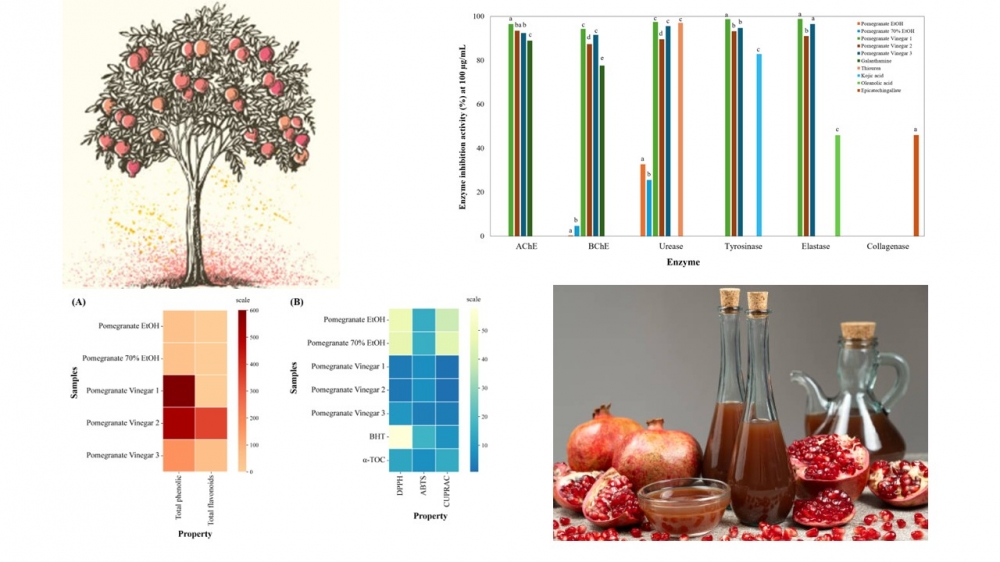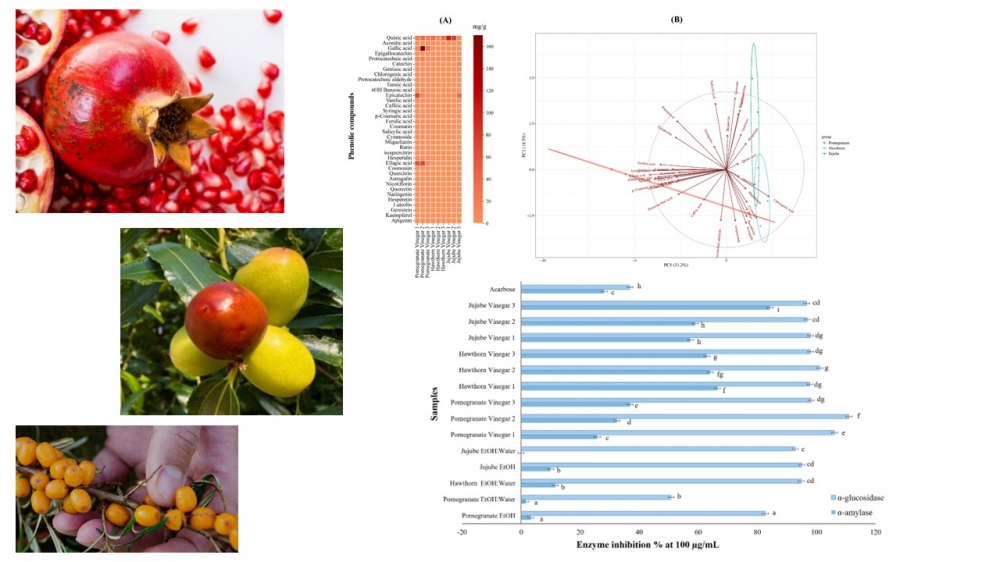Records of Agricultural and Food Chemistry
A scientific open access journal in the field of agricultural and food chemistry.LATEST ARTICLES
Comparative Evaluation of Antioxidant and Enzyme Inhibition Activities of Pomegranate Vinegars and Extracts

In this study, antioxidant potential and enzyme inhibitory activities of pomegranate vinegars and extracts were investigated. Antioxidant activity was evaluated using ABTS, DPPH, and CUPRAC assays. Total phenol and flavonoid contents were also determined spectrophotometrically. The enzyme inhibition analysis comprised the assessment of anticholinesterase, anti-urease, and anti-aging (tyrosinase, elastase, and collagenase) targets. Pomegranate vinegars showed significantly higher total phenolic and total flavonoid contents with respect to crude extracts. The antioxidant activity of vinegar samples was higher, and one of the investigated vinegars (vinegar 2) exerted the highest radical-scavenging ability (DPPH IC₅₀: 2.21±0.01 μg/mL). Enzyme inhibition assays demonstrated that vinegars showed a broad-spectrum activity against several targets. The maximum anticholinesterase activity (AChE: 96.53±1.47%; BChE: 94.35±0.74%) was observed by one of the vinegars (vinegar 1), exceeding that of galantamine. Another vinegar sample (vinegar 3) had remarkable elastase (96.57±1.80%) and collagenase inhibition. All vinegars exhibited potent inhibitory activity against α-glucosidase (up to 110.97±3.01%), significantly higher than acarbose. On the other hand, ethanolic extracts displayed weak or no inhibitory activities. Fermentation markedly improved the phenolic profile and multifunctional bioactivities of pomegranate products, providing vinegars with potent antioxidant, neuroprotective, anti-aging, and anti-urease activities. These results reveal pomegranate vinegar as a new functional food candidate with potent nutraceutical activities.
DOI http://doi.org/10.25135/rfac.37.2510.3654 Keywords Punica granatum Pomegranate vinegar Antioxidant capacity Enzyme inhibition Anti-cholinesterase Available online: November 10, 2025 DETAILS DOWNLOAD PDF © ACG Publications. All rights reserved.From Phenolics to Function: Anti-Diabetic Potentials of Hawthorn, Pomegranate and Jujube Vinegars

This study aimed to compare the phenolic profile and antidiabetic activities of extracts and vinegars of pomegranate, hawthorn, and jujube. Extracts and vinegars of plants were evaluated by LC–MS/MS for their individual phenolic profiles. Antidiabetic potential was assessed in vitro by measuring α-amylase and α-glucosidase inhibition with acarbose as a positive control. Results showed unique phenolic profiles: pomegranate extracts and vinegar (especially pomegranate vinegar 2) were enriched in ellagic acid (68.76 mg/g) derivatives; hawthorn 70% ethanolic extract in quinic acid (89.355 mg/g) and hawthorn vinegar 1 in quinic acid (35.899 mg/g) and flavonol glycosides; and jujube ethanolic extract in quinic acid (77.803 mg/g), jujube vinegar 1 in quinic acid (101.568 mg/g) and protocatechuic derivatives. Vinegar fermentation enhanced phenolic recovery, resulting in higher levels of bioactive compounds compared to extracts, and it improved the recovery of phenolics, as the amounts of bioactive compounds were higher in vinegars than in extracts. Both pomegranate and hawthorn vinegar 2 exerted the highest α-glucosidase inhibitions (110.97±3.01 and 101.08±1.71). Jujube vinegars (especially jujube vinegar 1) showed complementary features with greater enzyme inhibitions (97.96±1.27) along with previously reported insulin-sensitivity properties. This is the first study to provide a comparative evaluation of phenolic composition and antidiabetic potential of pomegranate, hawthorn, and jujube vinegars.
DOI http://doi.org/10.25135/rfac.38.2510.3655 Keywords Pomegranate Hawthorn Jujube Vinegars Phenolic Enzym Inhibition Available online: November 10, 2025 DETAILS DOWNLOAD PDF © ACG Publications. All rights reserved.A Comprehensive Review on the Chemical Composition and Biological Activity of Pleurospermum angelicoides (DC.) Benth. ex C.B.Clarke

Pleurospermum angelicoides, a perennial Apiaceae herb native to the high-altitude Himalayan region, has long been valued in traditional medicine for treating ailments such as fever, typhoid, and dysentery. Despite this ethnomedicinal relevance, comprehensive scientific syntheses on its phytochemistry and pharmacology remain limited. This review addresses this gap by systematically compiling and analysing literature on the species’ distribution, morphology, traditional uses, phytochemical diversity, and biological activities. Sources were identified through targeted searches of peer-reviewed journals, ethnobotanical records, and phytochemical databases. The available evidence highlights a remarkable spectrum of bioactive constituents, including coumarins, phenylpropanoids (e.g., nothoapiole, α-asarone), and terpenoids (p-cymene, camphene), with notable variations in essential oil profiles across plant parts and geographic locations. Pharmacological studies confirm antimicrobial and antioxidant activities, validating several traditional claims and underscoring the therapeutic promise of its extracts and essential oils. These findings suggest that P. angelicoides could serve as a natural source of lead compounds for novel drug development. In addition to summarising current knowledge, this review emphasises critical research gaps, particularly regarding molecular mechanisms, pharmacodynamics, and clinical validation. Unlike earlier scattered reports, it provides the first integrative account of the species’ phytochemical and pharmacological potential, thereby establishing a foundation for its broader application in modern herbal medicine and pharmaceutical innovation.
DOI http://doi.org/10.25135/rfac.36.2508.3627 Keywords Pleurospermum angelicoides food preservation ethnomedicine phytochemistry antimicrobial activity antioxidant potential Available online: October 24, 2025 DETAILS DOWNLOAD PDF © ACG Publications. All rights reserved.Role of Soil and Environmental Factors in Predicting Physical and Mechanical Properties of Black Alder Wood: CCA Aided MLR Modeling Approach

This study aimed to determine and model the relationships between some physical and mechanical properties of wood and physical and chemical properties of the soil, soil nutrient cations, and environmental factors in Alnus glutinosa subsp. barbata stands naturally growing in the Artvin region. Canonical Correlation Analysis (CCA) was employed to identify the relationships between the dependent and independent variables. Stepwise Multiple Linear Regression (MLR) Analysis was used to model the physical and mechanical properties. According to the CCA analysis results, a strong relationship was determined between MOR, MOE, and OWD and chemical soil properties such as pH, Mg, and K (CCA1, r = 0.89). In addition, a significant relationship was determined between CPG and DB and moisture and topographic factors such as AWC, FC, WP, and ALT (CCA2, r = 0.52). As a result of the MLR analysis, the model created for compressive strength parallel to grain explained 55% of the variance (R² = 0.552, RMSE = 35.66); The models created for oven-dry wood density and modulus of elasticity explained 54% (R² = 0.541, RMSE = 0.0352) and 38% (R2 = 0.386, RMSE = 530.99) of the variance, respectively.
DOI http://doi.org/10.25135/rfac.35.2506.3566 Keywords Artvin CCA MLR nutrient soil properties Available online: August 16, 2025 DETAILS DOWNLOAD PDF © ACG Publications. All rights reserved.